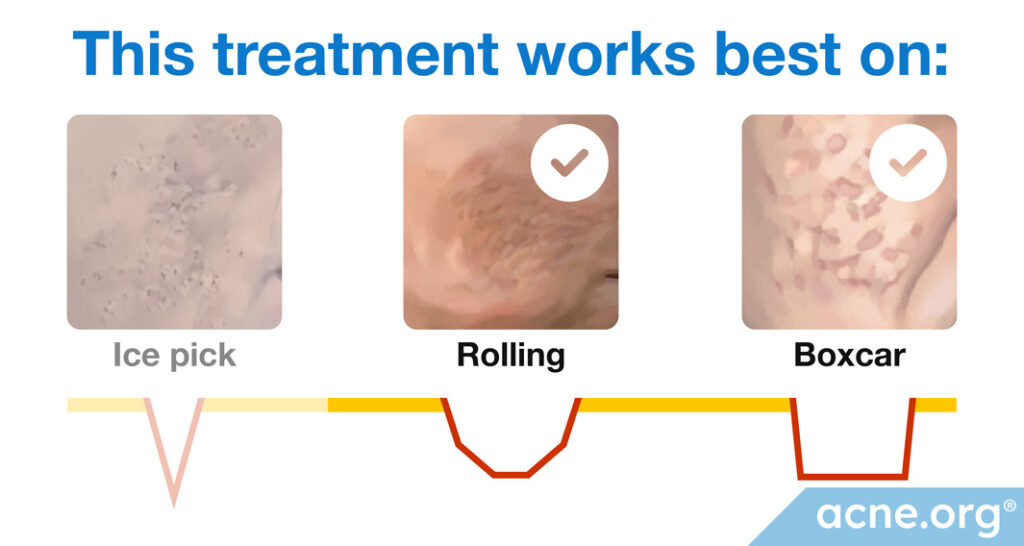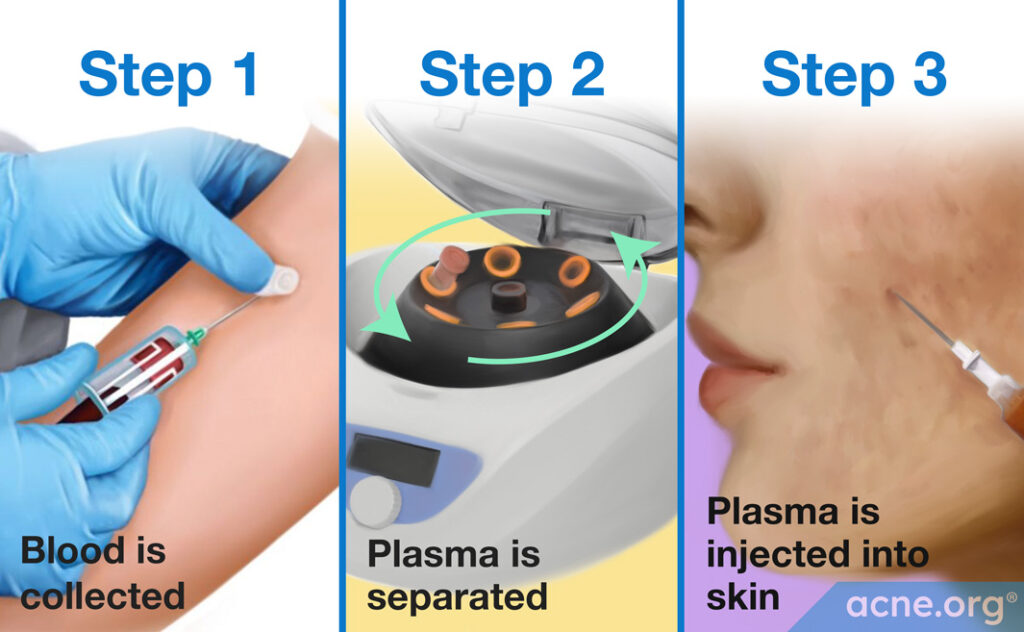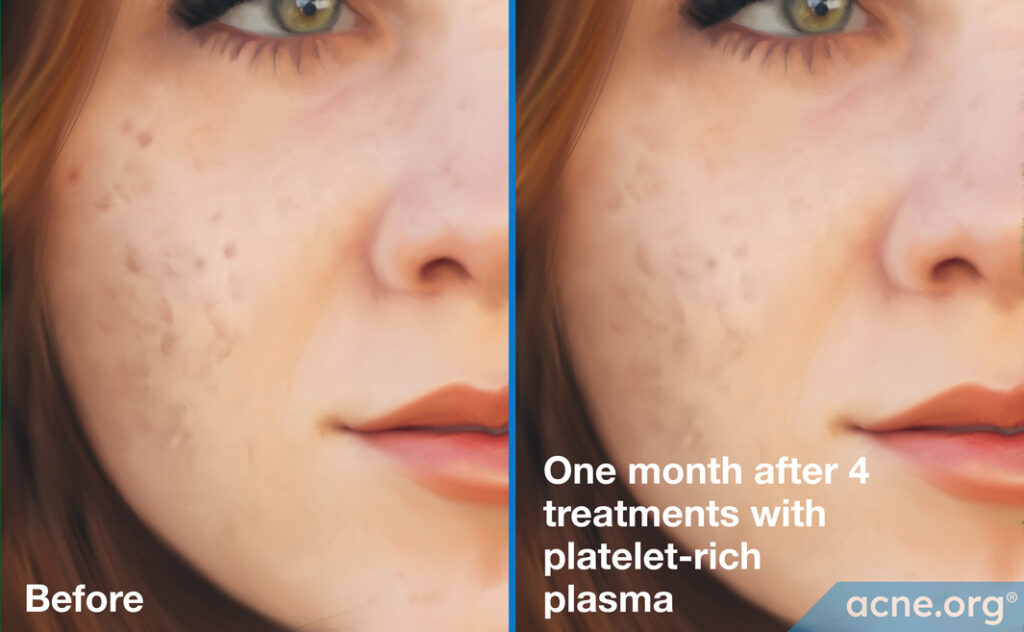
* Platelet-rich plasma works best on rolling and boxcar scars.
Platelet-rich plasma (PRP) procedure is an uncomfortable and sometimes painful procedure used for treating all types of atrophic (indented) scars. It is also commonly used to treat hair loss, wrinkles, acute sports or tendon injuries, and osteoarthritis.1
During the procedure, a medical professional extracts the patient’s blood just before the start of the treatment and isolates plasma from it. Isolated plasma contains high levels of platelets which is why it is called platelet-rich plasma (PRP). PRP also contains growth factors that can encourage the production of collagen and elastin and help with skin reconstruction.2,3 PRP is injected beneath the scar to stimulate the formation of tissue beneath the skin’s surface.
PRP also goes by other names, including:
- Platelet-rich Plasma Therapy
- Autologous Platelet Concentrate Therapy
- Platelet-rich Plasma Injection
- PRP Regenerative Therapy
- Platelet-enriched Plasma Treatment
- PRP Healing Procedure
Compared to other scar revision procedures, PRP has several advantages:
- A short recovery period of 1-2 days
- Low risk of side effects
- Long-lasting results1,2
On the other hand, PRP has some disadvantages:
- Not as effective as some other scar treatments
- Can be painful
- It may take weeks to start seeing results
PRP can sometimes be combined with other scar revision procedures, such as microneedling, or fractional ablative CO2 laser. Talk to your dermatologist or plastic surgeon to understand what options are available and what procedure(s) will be the most suitable for you.
People with active acne should not undergo acne scar repair of any kind, including PRP. Make sure your skin is clear of acne before beginning scar treatment.
Before agreeing to undergo PRP ask multiple medical professionals about their opinions, proposed treatments, expected outcomes, and prices.
Procedure details:

The first part of the procedure is obtaining platelet-rich plasma from the patient. To do that, a medical professional collects a small amount of blood from your arm. The blood is then placed in a machine called a centrifuge, which separates platelet-rich plasma from the rest of the blood.4,5
Some doctors choose to add other compounds to PRP to enhance the healing properties of the extracted part of the blood during the PRP preparation process, such as:
- Additional growth factors to stimulate the activation of the healing process
- Calcium salts to prevent coagulation of plasma
- Painkillers or analgesics to help reduce the discomfort and possible pain you might feel after receiving the PRP injection3

Once the platelet-rich plasma is isolated, a medical professional will use a fine, thin needle to inject it into the skin to reach the mid to deep dermis (the second, deeper layer of the skin). This will allow the platelet-rich plasma to interact with the cells in the dermis and promote collagen production and tissue regeneration.4
Anesthesia:
PRP can be uncomfortable and even painful, so if you undergo this treatment, a medical professional will probably apply a topical anesthetic, such as a cream containing the numbing drug lidocaine, to your skin before beginning the treatment.6
Before-and-after:

Acne scars before and one month after 4 treatments with PRP.
References
- Hesseler MJ, Shyam N. Platelet-rich plasma and its utility in medical dermatology: A systematic review. J Am Acad Dermatol. 81(3), 834-46 (2019).
- Ebrahimi Z, Alimohamadi Y, Janani M, Hejazi P, Kamali M, Goodarzi A. Platelet-rich plasma in the treatment of scars, to suggest or not to suggest? A systematic review and meta-analysis. J Tissue Eng Regen Med. 16(10), 875-99 (2022).
- Pixley JN, Cook MK, Singh R, Larrondo J, McMichael AJ. A comprehensive review of platelet-rich plasma for the treatment of dermatologic disorders. J Dermatolog Treat. 34(1), 2142035 (2023).
- Deshmukh NS, Belgaumkar VA. Platelet-Rich Plasma Augments Subcision in Atrophic Acne Scars: A Split-Face Comparative Study. Dermatol Surg. 45(1), 90-8 (2019).
- Cleveland Clinic. Platelet rich plasma. Available from: https://my.clevelandclinic.org/health/treatments/21102-platelet-rich-plasma#procedure-details
- Asif M, Kanodia S, Singh K. Combined autologous platelet-rich plasma with microneedling verses microneedling with distilled water in the treatment of atrophic acne scars: a concurrent split-face study. J Cosmet Dermatol. 15(4), 434-43 (2016).
- Hassan AS, El-Hawary MS, Abdel Raheem HM, Abdallah SH, El-Komy MM. Treatment of atrophic acne scars using autologous platelet-rich plasma vs combined subcision and autologous platelet-rich plasma: A split-face comparative study. J Cosmet Dermatol. 19(2), 456-61 (2020).
- Diab NAF, Ibrahim AM, Abdallah AM. Fluid Platelet-Rich Fibrin (PRF) Versus Platelet-Rich Plasma (PRP) in the Treatment of Atrophic Acne Scars: A Comparative Study. Arch Dermatol Res. 315(5), 1249-55 (2023).
 Acne.org Products
Acne.org Products